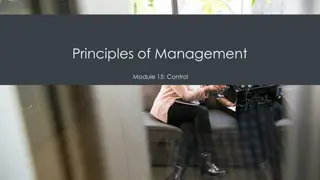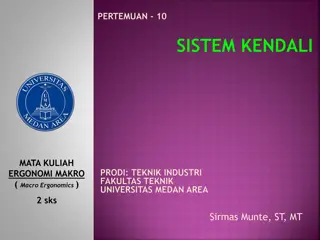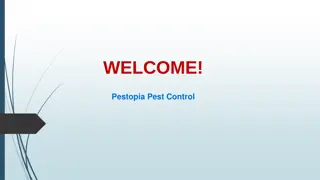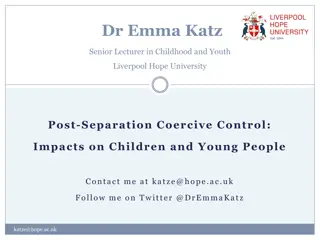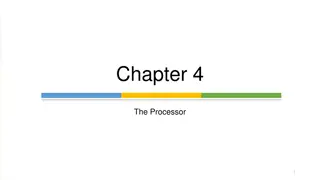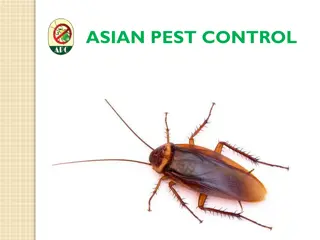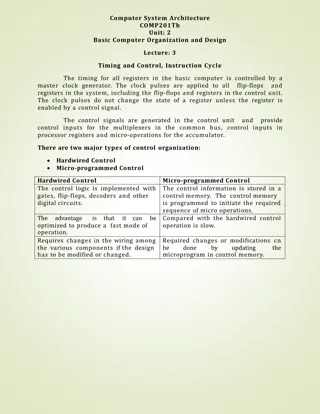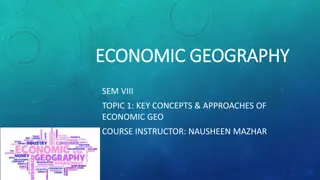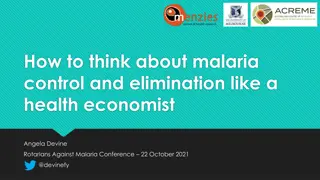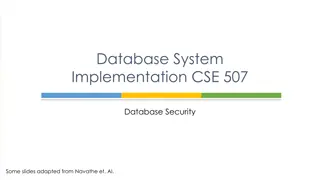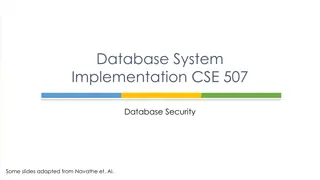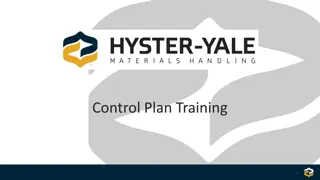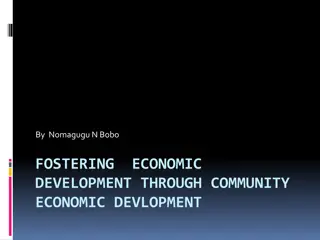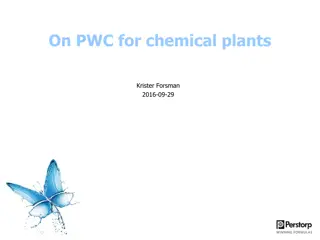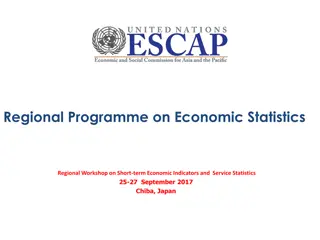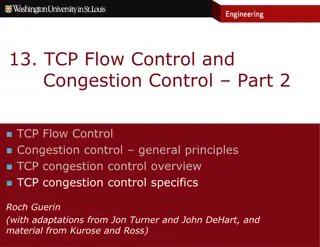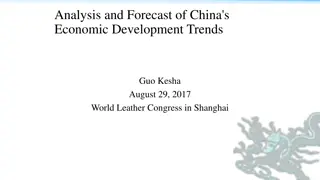Economic Plantwide Control Overview
Economic Plantwide Control is a critical concept in process engineering, aiming to optimize operation efficiency while minimizing costs and environmental impact. The approach involves multiobjective optimization, centralized control theory, and systematic design of control systems for complete plants. Case studies, practical rules, and dynamic simulations are key components to achieve optimal operation. Sigurd Skogestad's work at the Norwegian University of Science and Technology provides valuable insights into this field.
Download Presentation

Please find below an Image/Link to download the presentation.
The content on the website is provided AS IS for your information and personal use only. It may not be sold, licensed, or shared on other websites without obtaining consent from the author.If you encounter any issues during the download, it is possible that the publisher has removed the file from their server.
You are allowed to download the files provided on this website for personal or commercial use, subject to the condition that they are used lawfully. All files are the property of their respective owners.
The content on the website is provided AS IS for your information and personal use only. It may not be sold, licensed, or shared on other websites without obtaining consent from the author.
E N D
Presentation Transcript
1 ECONOMIC PLANTWIDE CONTROL Sigurd Skogestad Dept. of Chemical Engineering, Norwegian University of Science and Technology, Trondheim, Norway 1 Economic Plantwide Control, July 2015
2 Trondheim, Norway 2
3 Arctic circle North Sea Trondheim SWEDEN NORWAY Oslo DENMARK GERMANY UK 3
4 Winter: No sun, but sometimes Aurora Borealis = Northern Lights Troms 4
5 NTNU,Trondheim 200 000 people 30 000 students 5
6 ECONOMIC PLANTWIDE CONTROL OUTLINE INTRODUCTION PROCEDURE FOR ECONOMIC PLANTWIDE CONTROL REACTOR-SEPARATOR-RECYCLE CASE STUDY PRACTICAL RULES DYNAMIC SIMULATIONS CONCLUSIONS 6
7 Optimal operation (economics) Example of systems we want to operate optimally Process plant minimize J=economic cost Runner minimize J=time Green process plant Minimize J=environmental impact (with given economic cost) General multiobjective: Min J (scalar cost, often $) Subject to satisfying constraints (environment, resources) 7
8 Theory: Optimal operation Objectives Theory: Model of overall system Estimate present state Optimize all degrees of freedom CENTRALIZED OPTIMIZER Present state Model of system Problems: Model not available Optimization complex Not robust (difficult to handle uncertainty) Slow response time Process control: Excellent candidate for centralized control (Physical) Degrees of freedom 8
10 HOW DESIGN THE CONTROL SYSTEM FOR A COMPLETE PLANT ? Famous critique article on process control by Foss (1973): The central issue to be resolved ... is the determination of control system structure. Which variables should be measured, which inputs should be manipulated and which links should be made between the two sets? There is more than a suspicion that the work of a genius is needed here, for without it the control configuration problem will likely remain in a primitive, hazily stated and wholly unmanageable form. The gap is present indeed, but contrary to the views of many, it is the theoretician who must close it. NEED A SYSTEMATIC APPROACH 10
11 MAIN OBJECTIVES FOR A CONTROL SYSTEM 1. Economics: Implementation of close-to-optimal economic operation 2. Regulation: Stable operation ARE THESE OBJECTIVES CONFLICTING? Usually NOT Different time scales Stabilization fast time scale Stabilization doesn t use up any degrees of freedom Reference value (setpoint) available for layer above But it uses up part of the time window (frequency range) 11
12 Our Paradigm PRACTICAL OPERATION: HIERARCHICAL STRUCTURE Manager Process engineer Operator/RTO CV1 Operator/ Advanced control /MPC PID-control u = valves 12
13 ECONOMIC PLANTWIDE CONTROL PROCEDURE Decompose the structural decisions into two parts: Top-down part: Find a slow-time-scale supervisory control structure that achieves a close-to-optimal economic operation. CV1 = Economic CVs CV = Controlled variable Figure 1: Typical control hierarchy in a chemical plant 13
14 ECONOMIC PLANTWIDE CONTROL PROCEDURE Decompose the structural decisions into two parts: Top-down part, which attempts to find a slow-time-scale supervisory control structure that achieves a close-to-optimal economic operation. Bottom - up part: Design a robust fast- time-scale regulatory control layer, which stabilizes the plant and follows the setpoints from the supervisory layer. CV2 = stabilizing CVs Figure 1: Typical control hierarchy in a chemical plant 14
15 ECONOMIC PLANTWIDE CONTROL STEPWISE PROCEDURE (Skogestad, 2004) I. Top Down Step S1: Define operational objectives (optimal economic operation) Cost function J (to be minimized) Operational constraints Step S2: Identify degrees of freedom (MVs) and optimize for expected disturbances Step S3: Select primary controlled variables CV1 (economic CVs) Step S4: Where to set the production rate? (TPM) II. Bottom Up Step S5: Regulatory / stabilizing control (PID layer) What more to control CV2(stabilizing CVs)? Pairing of inputs and outputs Step S6: Supervisory control (MPC layer) Step S7: Real-time optimization (Do we need it?) 15
16 ECONOMIC PLANTWIDE CONTROL Top-down part (mainly steady-state): : Step S1: Define the operational objectives (economics) and constraints. Identify A scalar cost function J [$/s] J = cost feed + cost energy value products operational constraints disturbances d and their ranges Two main cases (modes/regions) depending on market conditions: Mode 1. Given feedrate Mode 2. Maximum production (max feedrate) 16
17 ECONOMIC PLANTWIDE CONTROL Top-down part (mainly steady-state): : Step S2: Determine the degrees of freedom and find the steady-state optimal operation. Must optimize for the range of expected disturbances d Requires a rigorous model (usually steady-state) POTENSIALLY VERY TIME CONSUMING Main goal: Identify the ACTIVE CONSTRAINTS 17
18 ECONOMIC PLANTWIDE CONTROL Top-down part (mainly steady-state): : Step S3: Select primary (economic) controlled variables (CV1) Identify the candidate measurements ymand from these select a set CV1 (one CV for each steady-state degree of freedom): Control the active constraints! For the remaining unconstrained degrees of freedom: Control self-optimizing variables Figure 1: Typical control hierarchy in a chemical plant 18
19 Self-optimizing variables: Controlled variables (CV1), which when kept at constant setpoints, indirectly achieve close-to-optimal operation in spite of unknown disturbances Minimize the need for re-optimization by moving optimization into the control layer 19
Optimal operation - Runner 20 Optimal operation of runner Cost to be minimized, J=T One degree of freedom (u=powe) Disturbance (d) = hill or wind What should we control? 20
Optimal operation - Runner 21 1. Optimal operation of Sprinter 100m. J=T Active constraint control: Maximum speed ( no thinking required ) CV = power (at max) 21
Optimal operation - Runner 22 2. Optimal operation of Marathon runner 40 km. J=T What should we control? CV=? Unconstrained optimum J=T u=power uopt 22
Optimal operation - Runner 23 Self-optimizing control: Marathon (40 km) Any self-optimizing variable (to control at constant setpoint)? c1 = distance to leader of race c2 = speed d=hill J=T Loss CVopt CV=speed 23
Optimal operation - Runner 24 Self-optimizing control: Marathon (40 km) Any self-optimizing variable (to control at constant setpoint)? c1 = distance to leader of race c2 = speed c3 = heart rate c4= level of lactate in muscles d=hill J=T CVopt CV=heart rate 24
Optimal operation - Runner 25 J=T Conclusion Marathon runner c=heart rate copt select one measurement c = heart rate CV = heart rate is good self-optimizing variable Simple and robust implementation Disturbances are indirectly handled by keeping a constant heart rate May have infrequent adjustment of setpoint (cs) 25
26 ECONOMIC PLANTWIDE CONTROL Top-down part (mainly steady-state): Step S4: Select the location of throughput manipulator (TPM) Where should the plant s gas pedal (TPM) be located ? Usually one for each plant The location of the TPM is a dynamic issue but has an economic impact Answer: Often locate TPM at the feed, but to maximize throughput (Mode 2), should be located close the production bottleneck to avoid snowballing , locate inside recycle loop 26
27 ECONOMIC PLANTWIDE CONTROL Bottom-up part (mainly dynamic): Step S5: Select the control structure for the Regulatory Control layer Q1: What variables (CV2) should be controlled to stabilize the plant operation ? A1: Select drifting process variables CV2= H2ymthat need to be controlled to ensure safe and stable operation e.g. levels, pressures, temperatures. Q2: How should CV2be controlled (pairing)? A2: Controllability analysis Figure 1: Typical control hierarchy in a chemical plant 27
28 ECONOMIC PLANTWIDE CONTROL Bottom-up part (mainly dynamic): Step S6: Select the control structure for the Supervisory (Advanced) Control layer Objectives Control economic controlled variables CV1 Look after regulatory layer (avoid saturation of uD) Two alternatives: 1. Multivariable controller (e.g. MPC) 2. Mix of various advanced controllers including PID, selectors, feedforward 28
29 ECONOMIC PLANTWIDE CONTROL Bottom-up part (mainly dynamic): Step S7: Select the control structure for the Process Optimization layer (RTO) How should the optimal setpoints for CV1be updated ? A good choice of controlled variables (CV1) may remove the need for this layer. Figure 1: Typical control hierarchy in a chemical plant 29
30 REACTOR-SEPARATOR- RECYCLE CASE STUDY (Luyben) Feed F0 contains mostly A A. . Reactor (CSTR) 1st order A -> B reaction Constant temperature Separator (distillation column) Distillate D (mostly A ): recycled back to CSTR. Bottom product B (mostly B ) 22 stages Constant pressure Constant relative volatility D F0 B Reactor-separator-recycle process 30
31 CASE STUDY: Step S1 Definition of optimal operation: Given feedrate (Mode 1) J = cost feed + cost energy value products J = cFF0+ cVVB cBB Since F0 = B is given, this simplifies to min J = VB Reactor-separator-recycle process 31
32 CASE STUDY: Step S1 Definition of optimal operation: Given feedrate (Mode 1) J = cost feed + cost energy value products J = cFF0+ cVVB cBB Since F0 = B is given, this simplifies to min J = VB Operational constraints MR 2800 kmol VB 50 kmol/min xB 0.0105 (max. 1.05% A in product) Reactor-separator-recycle process 32
33 CASE STUDY: Step S2 Step S2: Determine the degrees of freedom and find the steady-state optimal operation. Given pressure and reactor temperature: 6 dynamic manipulated variables (valves) uD = {F0, VB, D, B, F, LT} MDand MBhave no steady-state effect and need to be controlled Steady state and given feed F0: 3 steady-state degrees of freedom Step S3: Must find 3 economic variables to control (CV1) Reactor-separator-recycle process ??? 33
34 11 PRACTICAL RULES (TO HELP WITH THE REMAINING STEPS) 34
35 PRACTICAL RULES for Step S3 Step S3: Selection of economic CV1 Rule 1: Control the active constraints In general, process optimization is required to determine the active constraints. but a good engineer can often guess the active constraints. 35
36 PRACTICAL RULES for Step S3 Step S3: Selection of economic CV1 Rule 1: Control the active constraints In general, process optimization is required to determine the active constraints. but a good engineer can often guess the active constraints Rule 1A: The purity constraint of the valuable product is always active and should be controlled. This is to maximize valuable product and avoid product give away . 36
37 CASE STUDY Practical rules for Step S3: Selection of economic CV1 Rule 1: Control the active constraints Rule 1A: The purity constraint of the valuable product is always active and should be controlled. Case study: Both MR (max) and xB (purity valuable product) are active. Need to find one more CV1 Unconstrained optimum J=VB Reactor-separator-recycle process u = LT 37
38 PRACTICAL RULES for Step S3 Step S3: Selection of economic CV1 Rule 2: (for remaining unconstrained steady-state degrees of freedom, if any): Control self-optimizing variables. The two main properties of a good self-optimizing variable are: ts optimal value is insensitive to disturbances so F = CV1,opt / d is small t is sensitive to the plant inputs (= flat optimum ) so the process gain G = CV1/ u is large 38
39 PRACTICAL RULES for Step S3 Step S3: Selection of economic CV1 Rule 2: (for remaining unconstrained steady-state degrees of freedom, if any): Control the self-optimizing variables. The two main properties of a good self-optimizing variable are: ts optimal value is insensitive to disturbances (such that F = CV1,opt / d is small) t is sensitive to the plant inputs (so the process scaled gain G = CV1/ u is large). The following rule combines the two desired properties: Rule 2A: Select the set CV1such that the ratio G-1F is minimized. This rule is often called the Maximum scaled gain rule . 39
40 CASE STUDY: Self-optimizing variables Practical rules for Step S3: Selection of economic CV1 Rule 2: (for remaining unconstrained steady-state degrees of freedom, if any): Control the self-optimizing variables. The two main properties of a good self- optimizing variable are: ts optimal value is insensitive to disturbances (such that F = CV1,opt / d is small) t is sensitive to the plant inputs (so the process scaled gain G = CV1/ u is large). The following rule shows how to combine the two desired properties: Rule 2A: Select the set CV1such that the ratio G-1F is minimized. This rule is often called the Maximum scaled gain rule . Sensitive variables (with large scaled gain): Some good candidates for CV1,SOC : {LT/F , xD}. 40
41 PRACTICAL RULES for Step S3 Step S3: Selection of economic CV1 Rule 3: (for remaining unconstrained steady-state degrees of freedom, if any): Never try to control the cost function J (or any other variable with min or max at the optimal point). 1. The cost function J has no sensitivity to the plant inputs so G = 0, (which violates Rule 2A) 41
42 PRACTICAL RULES for Step S3 Step S3: Selection of economic CV1 Rule 3: (for remaining unconstrained steady-state degrees of freedom, if any): Never try to control the cost function J (or any other variable with min or max at the optimal point). 1. The cost function J has no sensitivity to the plant inputs at the optimal point and so G = 0, which violates Rule 2A. 2. Potential infeasibility : J u 42
43 CASE STUDY Practical rules for Step S3: Selection of economic CV1 Rule 3: (for remaining unconstrained steady-state degrees of freedom, if any): Never try to control the cost function J (or any other variable that reaches a min or max at the optimal point). Case study: Do not keep VBconstant (but may be used as a TPM) 43
44 PRACTICAL RULES for Step S4 Step S4: Location of throughput manipulator (TPM) Rule 4: Locate the TPM close to the process bottleneck. This is to be able to maximize the production rate (Mode 2) Gives a simpler transition between mode 1 (given feed) and mode 2 (Process bottleneck is defined as the last constraint to become active when increasing the throughput rate.) Rule 5: (for processes with recycle) Locate the TPM inside the recycle loop. This is to avoid overfeeding the recycle loop = snowballing (Luyben) 44
45 CASE STUDY Practical rules for Step S4: Location of throughput manipulator (TPM) Rule 4: Locate the TPM close to the process bottleneck. Rule 5: (for processes with recycle) Locate the TPM inside the recycle loop. According to Rules 4 and 5 the best candidate for TPM location is VB. 45
46 PRACTICAL RULES for Step S5 Step S5: Structure of regulatory control layer Rule 6: Arrange the inventory control loops (for level, pressures, etc.) around the TPM location according to the radiation rule (Georgakis) This ensures local consistency i.e. all inventories are controlled by their local in or outflows. TPM TPM TPM 46
47 PRACTICAL RULES for Step S5 Step S5: Structure of regulatory control layer Rule 7: Select sensitive/drifting variables as controlled variables CV2for regulatory control. Typically include inventories (levels and pressures), reactor temperature, or a sensitive temperature in a distillation column. 47
48 PRACTICAL RULES for Step S5 Step S5: Structure of regulatory control layer Rule 8: Economically important active constraints (CV1) should be selected as CVs (CV2) in the regulatory layer. Economic variables CV1are generally controlled in the supervisory layer. But moving CV1to a faster layer may ensure tighter control with a smaller back-off. 48
49 PRACTICAL RULES for Step S5 Step S5: Structure of regulatory control layer Rule 9: ( Pair-close rule): The pairings should be selected such that, effective delays and loop interactions are minimal. 49
50 PRACTICAL RULES for Step S5 Step S5: Structure of regulatory control layer Rule 10: Avoid using MVs that may optimally saturate (at steady state) to control CVs in CV2. The reason is that we want to avoid re-configuring the regulatory control layer. To follow this rule, one needs to consider also other regions of operation than the nominal. 50
51 CASE STUDY Practical rules for Step S5: Structure of regulatory control layer Rule 7: Select sensitive/drifting variables as controlled variables CV2for regulatory control. Typically include inventories (levels and pressures), reactor temperature, or a sensitive temperature in a distillation column Rule 6: Arrange the inventory control loops (for level, etc.) around the TPM location according to the radiation rule. Rule 8: Economically important active constraints (CV1) should be selected as CVs (CV2) in the regulatory layer Rule 9: ( Pair-close rule): The pairings should be selected such that, effective delays and loop interactions are minimal. Rule 10: Avoid using MVs that may optimally saturate (at steady state) to control CVs in CV2. 51



